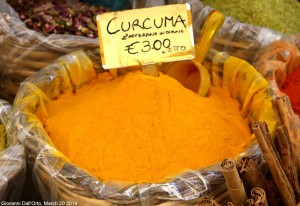
Any cook or foodie savouring South Asian and Middle Eastern dishes, will prize the key spice, the mustard coloured turmeric powder. In this guest post, Deirdre Hoban, a PhD student from Galway Neuroscience Centre, informs us that the spice’s uses extend beyond one’s culinary needs as it could serve a role in modern medicine.
Turmeric (Curcuma longa) is a rhizomatous plant of the ginger family that is conventionally used as a spice in Asian cuisine due to its characteristic yellow colour and pungent aroma. However, it has also been used for centuries as a remedy for various ailments in traditional Eastern medicine. The role of turmeric in traditional medicine is indicated by its presence in medicinal preparations described in traditional Ayurvedic medicine as far back as 250 B.C. In recent time, researchers have begun to investigate the therapeutic validity of these ancient remedies, and indeed there is considerable scientific evidence to support the therapeutic efficacy of turmeric and its extracts.
These recent studies initially focused on the therapeutic efficacy of the turmeric extract, curcumin. However the development of curcumin as a drug has been hampered by the compound’s extremely poor oral bioavailability. Another turmeric extract, turmeric oil, is not hampered by issues of bioavailability and researchers are investigating the therapeutic potential of it and its constituents. In particular, the antioxidant and anti-inflammatory compound, aromatic turmerone, is the most abundant constituent of turmeric oil, and this is being actively researched for its efficacy in disorders as diverse as cancer, diabetes and epilepsy.

In addition to these disease targets, a recent report from the Max Planck Institute for Metabolism Research in Cologne, Germany (published in Stem Cell Research & Therapy), has also revealed the neuroregenerative potential of aromatic turmerone which may have implications for treating neurodegenerative diseases such as stroke, Alzheimer’s disease, Parkinson’s disease and Huntington’s disease.
In this study, the authors harnessed positron emission tomography (PET) imaging technology to visualise endogenous neural stem cell mobilization in vivo, and demonstrated that aromatic turmerone can enhance the proliferation, mobilization and differentiation of neural stem cells (from the subventricular zone and the hippocampus) in the brain. Although endogenous neural stem cells have been shown to be mobilized from their specific niches in the degenerating brain, their inherent regenerative response is inadequate for functional recovery. Therefore, the potential of aromatic turmerone to enhance this endogenous repair/recovery process is intriguing.
From a personal experience with invasive brain repair strategies (through donor cell transplantation in experimental models), the ability of aromatic turmerone to stimulate the mobilization of endogenous neural stem cells without the need for invasive surgical intervention makes it a compound worth pursuing to promote regeneration in neurodegenerative disease. Indeed, this poses an interesting question to the scientific community: what other natural compounds that have their roots in traditional medicine may underlie the medicines of the future?
One Comment